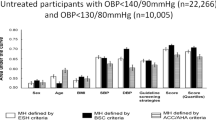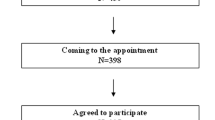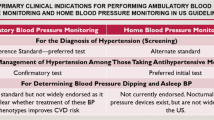Abstract
Ambulatory blood pressure monitoring (ABPM) is an accurate method for evaluating hypertension, yet its use in clinical practice may be limited by availability, cost and patient inconvenience. The objective of this study was to investigate the ability of a 6-h ABPM window to predict blood pressure control, judging by that of the full 24-h ABPM session across several clinical indications in a cohort of 486 patients referred for ABPM. Sensitivities and specificities of the 6-h systolic blood pressure mean to accurately classify patients as hypertensive were determined using a fixed reference point of 130 mm Hg for the 24-h mean. For four common indications, in which ABPM was ordered, prediction tables were constructed varying the thresholds for the 6-h mean to find the optimal value that best predicted the 24-h hypertensive status as determined from the full 24-h interval. Using a threshold of 137 mm Hg for the indications of borderline hypertension, evaluation of current antihypertensive regimen and suspected white-coat hypertension, sensitivity and specificity ranged from 0.83–0.88 to 0.80–0.88, respectively, for the ability of 6-h ABPM to correctly categorize hypertensive status. Using 133 mm Hg as the threshold for treatment resistance resulted in a sensitivity and specificity of 0.93 and 0.83, respectively. We conclude that a shortened ABPM session of 6 h can be used to accurately classify blood pressure as controlled or not, based on the results of a 24-h session. The optimal 6-h threshold for comparison depends upon indication for referral.
This is a preview of subscription content, access via your institution
Access options
Subscribe to this journal
Receive 12 digital issues and online access to articles
$119.00 per year
only $9.92 per issue
Buy this article
- Purchase on Springer Link
- Instant access to full article PDF
Prices may be subject to local taxes which are calculated during checkout

Similar content being viewed by others
References
Pickering TG, Shimbo D, Haas D . Ambulatory blood-pressure monitoring. N Engl J Med 2006; 354: 2368–2374.
Pickering TG, Miller NH, Ogedegbe G, Krakoff LR, Artiniann NT, Goff D . Call to action on use and reimbursement for home blood pressure monitoring: a joint scientific statement from the American Heart Association, American Society of Hypertension, and Preventive Cardiovascular Nurses Association. Hypertension 2008; 52: 10–29.
Staessen JA, Thijs L, Fagard R, O’Brien ET, Clement D, de Leeuw PW et al. Predicting cardiovascular risk using conventional vs ambulatory blood pressure in older patients with systolic hypertension. Systolic Hypertension in Europe Trial Investigators. JAMA 1999; 282: 539–546.
Clement DL, De Buyzere ML, De Bacquer DA, de Leeuw PW, Duprez DA, Fagard RH et al. Prognostic value of ambulatory blood-pressure recordings in patients with treated hypertension. N Engl J Med 2003; 348: 2407–2415.
Stergiou GS, Argyraki KK, Moyssakis I, Mastorantonakis SE, Achimastos AD, Karamanos VG et al. Home blood pressure is as reliable as ambulatory blood pressure in predicting target-organ damage in hypertension. Am J Hypertens 2007; 20: 616–621.
Gaborieau V, Delarche N, Gosse P . Ambulatory blood pressure monitoring versus self-measurement of blood pressure at home: correlation with target organ damage. J Hypertens 2008; 26: 1919–1927.
Ernst ME . Nighttime blood pressure is the blood pressure. Pharmacotherapy 2009; 29: 3–6.
Chobanian AV, Bakris GL, Black HR, Cushman WC, Green LA, Izzo Jr JL . The Seventh Report of the Joint National Committee on Prevention, Dectection, Evaluation, and Treatment on High Blood Pressure: The JNC-7 Report. JAMA 2003; 289: 2560–2572.
Ernst ME, Bergus GR . Favorable patient acceptance of ambulatory blood pressure monitoring in a primary care setting in the United States: a cross-sectional survey. BMC Fam Pract 2003; 4: 15.
Degaute JP, van de Borne P, Kerkhofs M, Dramaix M, Linkowski P . Does non-invasive ambulatory blood pressure monitoring disturb sleep? J Hypertens 1992; 10: 879–885.
Fravel MA, Ernst ME, Weber CA, Dawson JD, Carter BL, Bergus GR . Influence of patient characteristics on success of ambulatory blood pressure monitoring. Pharmacotherapy 2008; 28: 1341–1347.
Ernst ME, Bergus GR . Ambulatory blood pressure monitoring. South Med J 2003; 96: 563–568.
Ernst ME, Weber CA, Dawson JD, O’Connor MA, Lin W, Carter BL et al. How well does a shortened time interval characterize results of a full ambulatory blood pressure monitoring session? J Clin Hypertens (Greenwich) 2008; 10: 431–435.
Pickering TG, Hall JE, Appel LJ, Falkner BE, Graves JW, Hill MN et al. Recommendations for blood pressure measurement in human and experimental animals: Part 1: blood pressure measurement in humans: a statement for professionals from the Subcommittee of Professional and Public Education of the American Heart Association Council on High Blood Pressure Research. Hypertension 2005; 45: 142–161.
Baumgart P, Kamp J . Accuracy of the SpaceLabs Medical 90217 ambulatory blood pressure monitor. Blood Press Monit 1998; 3: 303–307.
Williams B, Lindholm LH, Sever P . Systolic pressure is all that matters. Lancet 2008; 371: 2219–2221.
Wen SW, Kramer MS, Hoey J, Hanley JA, Usher RH . Terminal digit preference, random error, and bias in routine clinical measurement of blood pressure. J Clin Epidemiol 1993; 46: 1187–1193.
Yavuz BB, Yavuz B, Tayfur O, Cankurtaran M, Halil M, Ulger Z et al. White coat effect and its clinical implications in the elderly. Clin Exp Hypertens 2009; 31: 306–315.
Weber MA, Drayer JM, Wyle FA, Brewer DD . A representative value for whole-day BP monitoring. JAMA 1982; 248: 1626–1628.
Sheps SG, Bailey KR, Zachariah PK . Short-term (six hour), ambulatory blood pressure monitoring. J Hum Hypertens 1994; 8: 873–878.
Chanudet X, Chau NP, Larroque P . Short-term representatives of daytime and night-time ambulatory blood pressures. J Hypertens 1992; 10: 595–600.
Acknowledgements
This work was supported in part by the National Heart, Lung, and Blood Institute (1R01HL069801-01A1).
Author information
Authors and Affiliations
Corresponding author
Ethics declarations
Competing interests
The authors declare no conflict of interest.
Additional information
Presented in part at the 21st annual meeting of the American Society of Hypertension, May 2008. New Orleans, LA.
Rights and permissions
About this article
Cite this article
Ernst, M., Sezate, G., Lin, W. et al. Indication-specific 6-h systolic blood pressure thresholds can approximate 24-h determination of blood pressure control. J Hum Hypertens 25, 250–255 (2011). https://doi.org/10.1038/jhh.2010.66
Received:
Revised:
Accepted:
Published:
Issue Date:
DOI: https://doi.org/10.1038/jhh.2010.66
Keywords
This article is cited by
-
The accuracy of 8-hour ambulatory blood pressure monitoring, adjusted to seasons
Journal of Human Hypertension (2022)
-
ABPM Induced Alarm Reaction: A Possible Cause of Overestimation of Daytime Blood Pressure Values Reduced By Treatment with Beta-Blockers
High Blood Pressure & Cardiovascular Prevention (2016)



